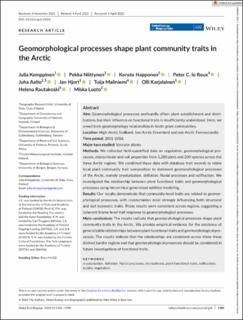Geomorphological processes shape plant community traits in the Arctic
Kemppinen, Julia; Niittynen, Pekka; Happonen, Konsta; le Roux, Peter C.; Aalto, Juha; Hjort, Jan; Maliniemi, Tuija; Karjalainen, Olli; Rautakoski, Helena; Luoto, Miska
Journal article, Peer reviewed
Published version

Åpne
Permanent lenke
https://hdl.handle.net/11250/3061971Utgivelsesdato
2022Metadata
Vis full innførselSamlinger
- Department of Biological Sciences [2235]
- Registrations from Cristin [9791]
Sammendrag
Aim
Geomorphological processes profoundly affect plant establishment and distributions, but their influence on functional traits is insufficiently understood. Here, we unveil trait–geomorphology relationships in Arctic plant communities.
Location
High-Arctic Svalbard, low-Arctic Greenland and sub-Arctic Fennoscandia.
Time period
2011–2018.
Major taxa studied
Vascular plants.
Methods
We collected field-quantified data on vegetation, geomorphological processes, microclimate and soil properties from 5,280 plots and 200 species across the three Arctic regions. We combined these data with database trait records to relate local plant community trait composition to dominant geomorphological processes of the Arctic, namely cryoturbation, deflation, fluvial processes and solifluction. We investigated the relationship between plant functional traits and geomorphological processes using hierarchical generalized additive modelling.
Results
Our results demonstrate that community-level traits are related to geomorphological processes, with cryoturbation most strongly influencing both structural and leaf economic traits. These results were consistent across regions, suggesting a coherent biome-level trait response to geomorphological processes.
Main conclusions
The results indicate that geomorphological processes shape plant community traits in the Arctic. We provide empirical evidence for the existence of generalizable relationships between plant functional traits and geomorphological processes. The results indicate that the relationships are consistent across these three distinct tundra regions and that geomorphological processes should be considered in future investigations of functional traits.
